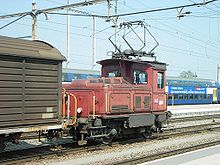Switcher
The shunting locomotive is a locomotive which, in contrast to the train locomotive, is not normally used for covering train journeys, but for journeys within a station (shunting).
Shunting locomotives are specially adapted for their use and thus usually have a center cab as well as shunting steps on which shunters riding along can stand. In the past, the locomotives were powered by steam generated by combustion (class 80 or 81) or externally by means of a steam accumulator, and later also by electric current supplied by the overhead line (class E 60 or E 63) and temporarily stored in accumulators (class E 80).
In Germany today, shunting locomotives are almost exclusively powered by a diesel engine so that overhead line-free track sections of a station, such as loading tracks, can be used. Exceptions are mainline locomotives with a battery or diesel module as a so-called last-mile device (Bombardier TRAXX 3) for shunting service or work trains (Henschel EA 800).
In Switzerland, on the other hand, electric shunting locomotives are used almost exclusively, as almost all tracks there, including loading and sidings, are covered by an overhead line.
The drive of shunting vehicles is usually designed for a high starting tractive force, not necessarily for a high final speed. Depending on the range of applications, different sized vehicles are used, ranging from small locomotives to large diesels with over 1,000 kW engine power (e.g. DB series 291). Shunting locomotives often have a very high dead weight for their size, since a higher frictional weight enables a greater starting tractive force.
In order to simplify the time-consuming coupling of the European screw coupling, many shunting locomotives have special automatic shunting couplers that engage in the train hook on the car. A number of modern shunting locomotives have remote control, which allows the locomotive shunting driver to be at the head of the shunting department at all times while the locomotive is in motion. On company railways and connecting railways, two-way vehicles are often used for shunting instead of shunting locomotives.
In addition to fully equipped locomotives, there are also shunting units. These do not have a cab and consist only of the drive unit and the coupler unit. They are often designed as two-way vehicles and are operated by remote control by the shunter. This type of vehicle is mostly used in industrial plants for shunting a few or single wagons. Here it would be uneconomical to operate a full-fledged shunting locomotive.

SBB Tem III346 dual power (shunting) tractor

Sulzer shunting loco E 2/2 N° 3, SLM built in 1907

Shunting locomotive of the DB class 360
Search within the encyclopedia